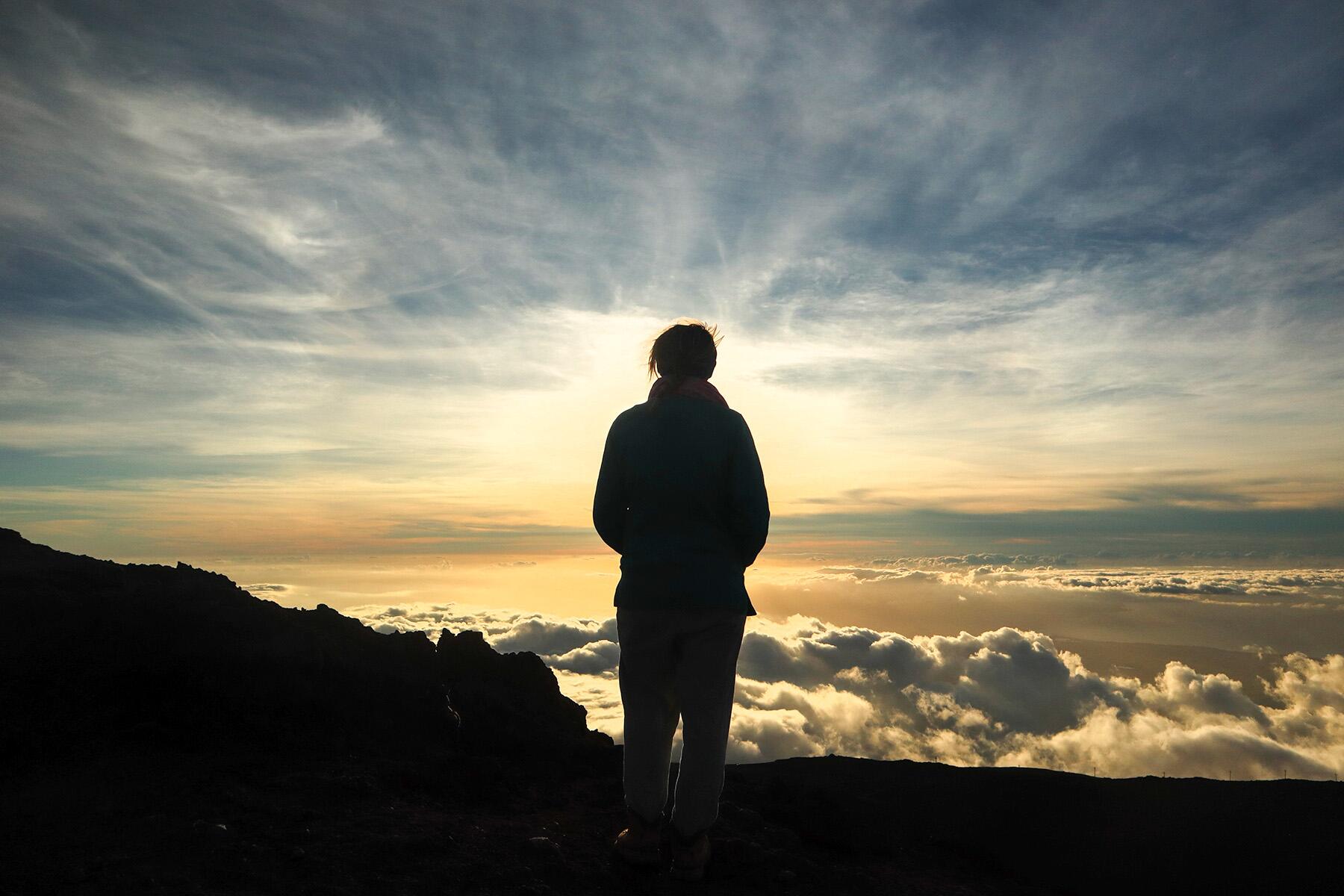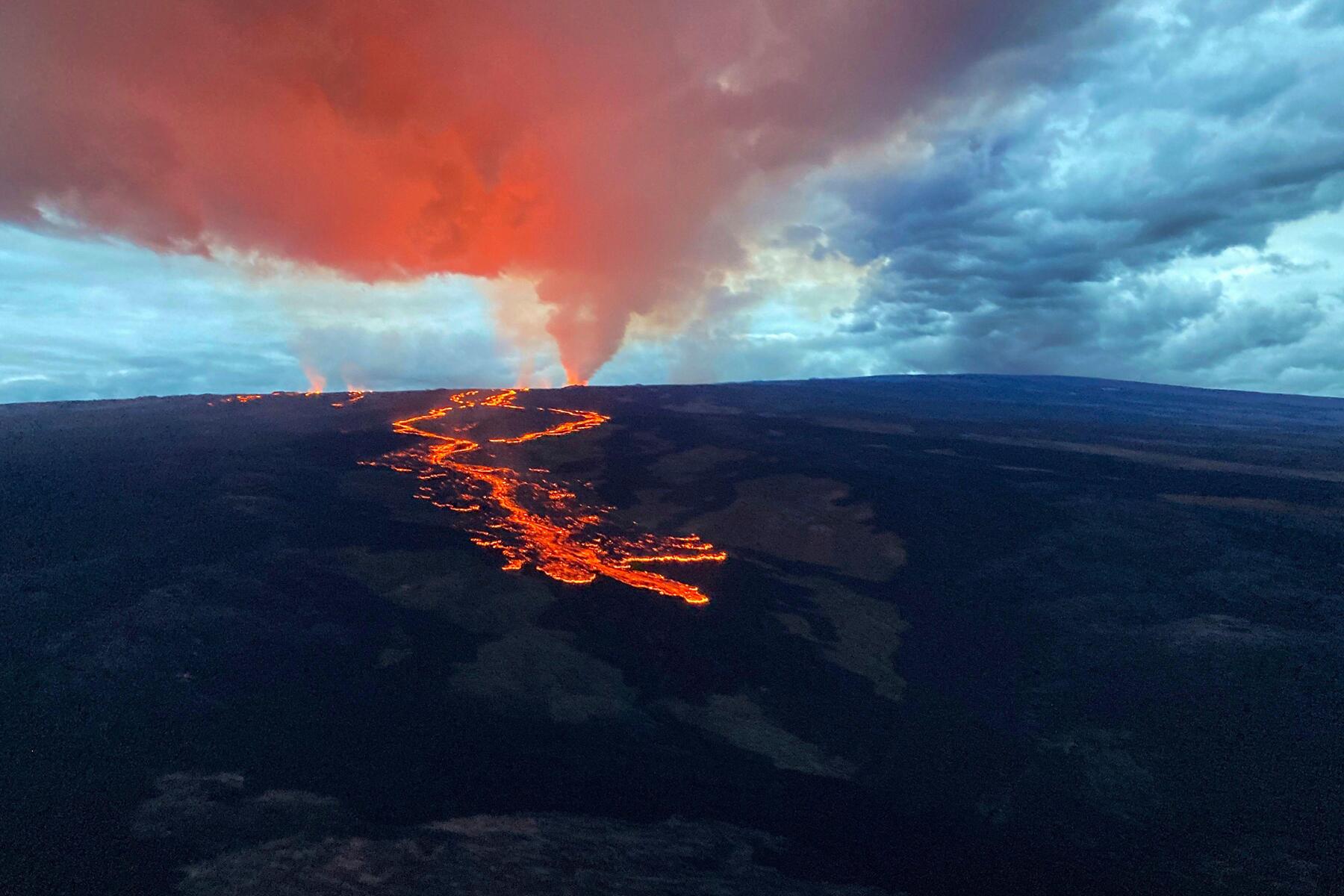“This is a very sacred event that we are watching.”
Mauna Loa, the world’s largest active volcano, is currently erupting! Even better, at the same time, Kīlauea is erupting, and there is snow at the summit of Mauna Kea. It’s a pretty magical moment on Hawai‘i Island. Mauna Loa hasn’t erupted since 1984, which was also the last time that Mauna Loa and Kīlauea were simultaneously erupting. The natural phenomena is attractive to a variety of people, including both residents and visitors, but with an ever-evolving situation that involves safety and health, it’s important to be informed before trying to catch a glimpse of these majestic flows.
If you’re wondering whether the eruption will impact your current or upcoming vacation plans, the short answer is that it will have very little impact on the other islands outside of potentially affecting air quality. As of right now on Hawai‘i Island, according to Hawai‘i County mayor Mitch Roth, “It’s a great time to come. You are seeing some of the most beautiful sights ever, and you can see it from all over the Island.”
It’s important to remember, however, that these volcanoes are of deep cultural and spiritual significance to the people of Hawai‘i, particularly to Native Hawaiians. Not only did volcanoes form the Hawaiian Island chain, one of the most significant gods in Hawaiian culture is associated with lava. Pele, goddess of volcanos and fire, is often referred to as Madame Pele or Tutu Pele. Poliʻahu, goddess of snow, is inextricably linked with Pele. Poli‘ahu once called Kīlauea home, but Pele claimed all of Kīlauea for herself, forcing Poliʻahu to the summit of Mauna Kea. The two became sworn enemies, their fire and ice personifications now visible across the Island. Kīlauea and Mauna Loa are now considered Pele’s domain, with Poli‘ahu controlling the snows and blizzards of Mauna Kea.
Recommended Fodor’s Video
As Jessica Ferracane from Hawai‘i Volcanoes National Park said, “This is a very sacred event that we are watching.”
In fact, Mauna Loa began erupting at 11:30 p.m. on November 27, just before the beginning of Hawaiian Independence Day on November 28. This is recognized as the day that Great Britain and France signed a proclamation acknowledging Hawai‘i as a sovereign nation-state. For those fighting for Hawai‘i to once again become a sovereign kingdom, this is an important day of the year and the eruption date is considered significant by many.
What’s Going On with Mauna Loa?
Mauna Loa is a shield volcano; its lava emerges in flows emanating either from the summit or vents that open along its rift zone. Though it can be explosive, it won’t violently blow its top like we saw in Jurassic World. That said, things can change very quickly and this eruption should be treated with the reverence and caution that it deserves.
As of the afternoon of November 30, the lava from Mauna Loa is running down its northeast flank and is a few miles away from the main thoroughfare that connects the east side of the Island (Hilo and Volcano Village) and the west side of the Island (Kailua-Kona and Waikoloa). Based on flow speed and topography, officials with the United States Geological Survey expect the lava to reach Daniel K Inouye Highway (aka Saddle Road) at some point, even as soon as within the next one or two weeks. Currently, no major residential areas are threatened by the flow. Mauna Loa Access Road and the Mauna Loa summit are closed.
Naturally, those visiting Hawai‘i will be intrigued by the unique opportunity to glimpse these eruptions, potentially a once in a lifetime experience. Here’s what you need to know if you’re visiting Hawai‘i right now (or soon).
INSIDER TIPThings can very quickly change with any eruption event, so it’s very important to utilize the resource list at the end of this article if you are planning a visit.
Visiting the Hawaiian Islands
Let’s start by zooming out to include all Hawaiian Islands. There isn’t a significant effect on the other Islands, including O‘ahu, Maui, and Kaua‘i; however, air quality can change and shift, leading to vog (CO2) and ash particulates being carried up the Island chain. Yes, that includes all the way up to O‘ahu. If you plan to visit and you have asthma or other breathing issues, it’s a good idea to bring an N95 mask and an extra inhaler with you if possible. Note that an N95 mask does not filter out CO2 and will only help with particulates, but does provide some relief. If you’re visiting, please plan ahead and bring one from home as the Islands often have to contend with shortages.
Folks visiting Maui will likely receive heavier vog levels due to proximity, but that proximity also means that some visitors may be able to see the Mauna Loa lava from the Valley Isle.
In fact, those visitors lucky enough to have a sunrise reservation at Haleakala have reported not just being able to see the glow, but that they can see the flow from the high (and relatively close) vantage point. Maui residents also expect some amazing sunsets thanks to the particulate matter reflecting the sunlight.
Visiting Hawai‘i Island
If your plans have you visiting Hawai‘i Island (also known as the Big Island), you likely do not need to make any adjustments as of right now. During the first day of the eruption, some flights were canceled but quickly resumed. Be sure to regularly check with your airline to see if they make any changes. No hotels have closed, and in fact some of the smaller boutique hotels like Puakea Ranch are happy to welcome lava lovers for a visit.
While staying in “Volcano Village” may sound scary, it’s actually one of the safest places you can stay if you’re worried about the lava flow. In fact, staying at one of the quiet, rainforest-set accommodations, like Volcano Village Estates, allows you the opportunity to see the glows of both Kilauea and Mauna Loa at the same time with a visit to nearby Hawai‘i Volcanoes National Park (HVNP).
If you are planning a visit, this is one of those trips where travel insurance really makes sense because things can change very quickly.
And if you’re planning a vacation and wondering if the lava will still be flowing and glowing when you arrive, well, who knows?!? Volcanos aren’t exactly subject to human timetables. Those of us living here hope that it doesn’t last too long because the potential for major damage is definitely there. While it’s a great attraction for visitors, people and animals call this Big Island home.
Where to View the Mauna Loa Lava
If you’re coming to visit, there are two main areas for viewing the lava flow. In addition, Paradise Helicopters and Blue Hawaiian Helicopters are running daytime flight tours.
The best area to view the lava along its Northeast Rift Zone is along Daniel K Inouye Highway, but cars have begun stopping, parking, and hanging out right along this 60mph highway frequented by large, commercial vehicles. Clouds, smoke, and roaming sheep, pigs, and goats all add to this already dangerous highway, making parking alongside the road the worst idea possible. In fact, it’s such a bad idea that Mayor Roth issued an emergency proclamation to address the issue and prevent people from parking and stopping (yes, plenty of people just stop in the middle of the highway to take photos):
WHEREAS, most of the DKI Highway between the sixteen mile marker (16 MM) and the thirty-one mile marker (31 MM) has a maximum speed limit of sixty (60) miles per hour, and it lacks sufficient infrastructure such as crosswalks and necessary lighting to safely sustain the increased amount of pedestrians arriving in vehicles in the area and traversing the area on foot, thereby creating unsafe road conditions.
WHEREAS, based on these unsafe road conditions, on November 28, 2022, at 09:25 p.m., pursuant to Sections 127A-25 and 291C-111, Hawai’i Revised Statutes as amended, I issued Emergency Rule #1 prohibiting all vehicles from stopping and/or or parking on the DKI Highway at any time between the sixteen mile marker (16 MM) and the thirty-one mile marker (31 MM), except as permitted at designated parking lots.
Instead of adding to the hazards (and potentially getting harmed yourself), try heading to Gilbert Kahele Recreation Area to park (they also have restrooms, making this a great place for families) or, as of Thursday, December 1, Old Saddle Road, which is a part of the Pohakuloa Training Area on the south side of Daniel K Inouye Highway, will be open for lava viewing via a traffic hazard mitigation route (THMR). The THMR will run one-way utilizing the Old Saddle Road that lies south of DKI. The entrance is located across from Gilbert Kahele Recreation Area, and the exit is just before Pu’uhuluhulu, spanning 4.5 miles. Parking will be allowed on the right side of THMR and will be limited to 90 minutes per vehicle. Safety officers will be present to help direct traffic flow.
In addition to the Northeast Rift Zone in the central area of the Island, lava watchers can head to Hawai‘i Volcanoes National Park for a chance to view both lava glows at the same time. HVNP is open 24/7 and ready for visitors. Though they are in a “slow” time for the next couple of weeks (right after Thanksgiving) they are expecting visitor numbers to increase and highly suggest visiting the park before 9am and after 9pm to help cut down on the crowds. HVNP has done an amazing job educating visitors via their social media and website. They’ve created a dedicated page where visitors can get information about where to park, best viewing sites, photos, etc.
Here are a few extra tips to make your visit go smoothly:
– The altitude at Mauna Kea Access Road (right across from the flow) is 6,560 feet elevation, making the air thinner and the temperature lower (last night was in the 50s, but with snow on Mauna Kea it will get colder). Mauna Kea Visitor’s Center is even higher at 9,200 feet elevation. Dress warmly and bring some hot cocoa with you (just don’t drink too much).
– The altitude inside HVNP is higher than at sea level and also gets cold at night, so bring layers and always plan for a little mist with light rain gear.
– Both Volcano Village (closest to HVNP) and the areas along DKI are more rural areas with very little in the way of gas, food, and restroom facilities. Gas up before leaving and eat or pick up food ahead of time. If you have a picnic, be sure to pack all of your trash out.
– Nighttime is very, very busy. Consider going to view before sunrise.
– One other hazard to watch out for is Pele’s hair, strands of volcanic glass. With characteristics similar to fiberglass, it’s not something you want to touch or get on you.
Also, it’s important to reinforce that Hawaiian culture is very different than the culture on the continent. Keep in mind that everything in the natural world is important to Hawaiians, including the lava rock from old flows that you might be standing on while viewing the current eruption. That means that it’s considered both pilau (gross) and offensive to relieve yourself while viewing the lava. Just don’t do it. Plan ahead. If you are heading up to view on Daniel K Inouye Highway the restrooms at Kahele Recreation Area are open. If you are headed to Hawai‘i Volcanoes National Park, do your business at the visitor’s center. Above all, be respectful and treat our home as you’d like everyone to treat yours.
Where Can I Find More Information?
Hawai‘i Tourism Authority puts out daily updates with information relevant to travelers.
USGS Hawaiian Volcano Observatory
Hawai‘i County Volcano Hazards
Dec. 1, 2022. 3:25 p.m. PST: This article has been updated with the latest viewing information.




